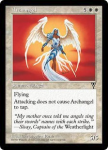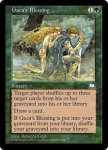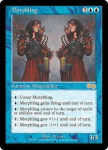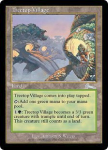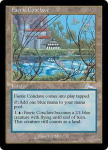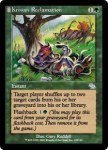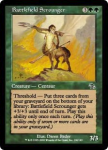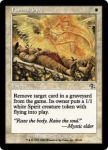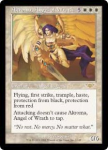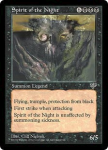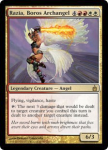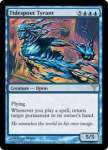So, Oath of Druids is part of a five-card cycle in Exodus. I recently did one of these threads for Sun Titan and remarked on how all five of the M11 Titans are at least decent cards, with most of them being quite strong. The Oaths are, um, not like that.
The white one is Oath of Lieges. During each player's upkeep, this enchantment lets that player check if any opponents have more lands than the player, and lets the player grab a basic land and put it directly onto the field if so. It's pretty good and I've actually used it myself somewhat. The obvious comparison is to Land Tax, and Oath of Lieges simply isn't the powerhouse that Land Tax is. Still, I'm surprised it doesn't see more play. Currently, my copy is in my mono-white EDH deck, "The End of Eternity."
The blue card in this cycle is Oath of Scholars. During each player's upkeep, this enchantment lets that player check if any opponents have more cards in hand, and if so it lets the player discard his or her hand and draw 3 cards. For some reason, it's the only one that costs four mana. Yeah, the other four Oaths are each a generic mana and a mana of their respective colors. Oath of Scholars costs 3U. Why? This is arguably the weakest member of the Oath cycle. I guess they were worried that if they made it only cost 1U, it would have been overpowered. I've never used this one and if I played against it, then it didn't make much of an impression.
The black one is Oath of Ghouls. During each player's upkeep, this enchantment lets that player check if any opponents have more creatures in their graveyards, and if so it gives the player a Raise Dead effect. Out of all four cards in the cycle, this is the only one on the Reserved List, so it's the most expensive one, even though only Oath of Druids has ever been reprinted at any point. I've always liked this one, but I don't think I ever acquired a copy of it. I should pick one up at some point. Realistically, the power level on this one is probably middling, and perhaps on the weak side of things. Black has lots of ways to get creatures out of graveyards. Even within the same set, there's Recurring Nightmare and Death's Duet, both of which probably have more overall utility value than Oath of Ghouls. In my own decks, Oversold Cemetery has been fun, and this is effectively a slightly more conditional version of that.
The red Oath is Oath of Mages. During each player's upkeep, this enchantment lets the player check if an opponent has more life, and if so it lets the player do 1 damage to that opponent. With some thought process that baffles me now, I actually used to play this card. I think it was in some kind of "Multiplayer Fun Deck" that used lots of card that let everyone participate in something. I said Oath of Scholars was arguably the weakest member of the cycle, but really I'd consider this the weakest one. What were they thinking? You're in red, so you have about a million ways to damage opponents. This card stops working for you if your opponent has less life than you and even when it is working, it only deals 1 damage. As a Burn aficionado, I have to condemn this as one of the weakest direct damage effects red has to offer. I like the art and I want to like this card, to find some way to redeem it. But it's just bad! I find myself compelled to agree with the person who made the comment on Gatherer: "Not only is it leagues less powerful than any of the other Oaths, it's just downright boring."
Of those four, my personal ranking would be Lieges > Ghouls > Scholars > Mages. The red one is sadly ineffective and the blue one costs too much mana to be of interest in most decks. But the black and white ones are both cool. Not all cards in cycles are created equal. In this case, while I do think that the white and black Oaths are far ahead of the blue and red ones, it's definitely the case that there's a tremendous gulf between the green Oath and the other four. During each player's upkeep, Oath of Druids lets that player check if any opponents control more creatures, and if so it lets the player reveal cards from the top of the player's library until finding a creature, then the creature goes onto the field and the other cards all go to the player's graveyard.
Despite the obvious similarities to the other four Oaths, the functional difference in usage here is dramatic. If I'm playing against Oath of Lieges, I probably just ignore it and let me opponent ramp for free. Eventually, my opponent either catches up to me on lands or has to employ some shenanigans like Zuran Orb or whatever. But it's not worth it to contest this advantage. I'd just play out my own gameplan.
If I'm playing against Oath of Scholars, then it might change my behavior. If I am playing a fast deck, I might try to empty my own hand to turn Oath of Scholars against my opponent. Or if I perceived the Oath of Scholars to potentially serve as a powerful draw engine for my opponent, I might seek to destroy it. If I'm playing a control deck, I probably either kill the Oath or ignore it.
If I'm playing against Oath of Ghouls, I probably don't try to get underneath my opponent graveyard creature count, because most decks aren't built to facilitate that. But I am probably looking to neutralize the creature that my opponent is seeking to recur with the Oath, such as by exiling it. That, or I just ignore it and try to win with my own gameplan. With some decks, I might try shuffling my graveyard back into my library or something.
If I'm playing against Oath of Mages, I'm probably more worried about some other card my opponent is using in order to squeeze value out of the Oath. It doesn't do much damage, so it's likely being paired with some kind of damage-multiplying effect, possibly in a black/red Suicide-style deck or something. So my priorities are automatically going to be dealing with whatever other cards are involved that make even something as paltry as a single damage-dealer dangerous.
Mostly, I can ignore or neutralize those enchantments on their own. If I'm playing against Oath of Druids, I have to be aware that any creature I play, no matter how small, could result in a free creature, and probably something big, from my opponent. Unlike the other Oaths, the green one forces me to adjust my gameplan with it in mind. I can try to avoid playing creatures in order to keep Oath of Druids turned off, but my opponent is obviously prepared for that scenario. I can try to play aggressively and kill my opponent before the Oath has a chance to do much, but that can be extremely dangerous.
The classic scenario that made this card infamous goes something like, "Opponent plays a one-drop creature. You play Oath of Druids. On your next turn, you cheat out a big creature that takes over the game while your opponent has a one-drop creature and maybe a two-drop creature." But from the beginning, Oath decks were built to be able to defeat opponents even if they never dropped a creature at all. To this end, Oath decks run lots of control cards, typically blue ones. The archetypal Oath deck is one of the most potent and longstanding marriages between blue and green. If your opponent plays a creature, you have Oath to get your win condition and your countermagic to protect that package. If your opponent doesn't play any creatures, you have all the time you need to play a grindy control game, which your deck is built to do anyway. In Vintage, this strategy is still going strong in 2021. There have been some major developments over the years since Oath decks first emerged in 1998, but the basic principle of running huge, domineering creatures as Oath payloads in a deck otherwise loaded with hard control spells has been there all along.

